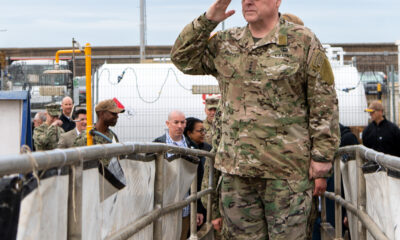Civilization
The Navy: Dead in the Water?
The United States Navy faces many challenges that, if not addressed, will lead to total mission failure. A retired captain speaks out.

Mission: The United States is a maritime nation, and the U.S. Navy protects America at sea. Alongside our allies and partners, we defend freedom, preserve economic prosperity, and keep the seas open and free. Our nation is engaged in long-term competition. To defend American interests around the globe, the U.S. Navy must remain prepared to execute our timeless role, as directed by Congress and the President.
The preceding statement is from the U. S. Navy’s website.
There are many indicators that the Navy is at increasing risk of mission failure.
- Missing recruiting goals by thousands for two years in a row, missing its goal for FY 2023 by over 7000 new recruits. The impact of missing recruiting goals is cumulative. Its impact does not subside if in subsequent years deficits are not made up. Lack of manpower adds to the strain of a Navy struggling to meet its national priorities overseas. Failing to recruit enough people to man the Navy is a result of many factors. Since the Afghanistan debacle, the public’s faith in the military has plummeted to new lows. With relatively low unemployment, the competition for young people is high. American youth are less fit, less capable of serving in the military than at any time in our history. Fewer young people want to serve as the political left teaches them to hate our country, academia promotes socialism, and race hustlers malign our country for its supposed racism and white supremacy. Divisive ideologies like Critical Race Theory and Diversity, Equity, and Inclusion are now promoted vigorously up and down the chain of command in the Navy. These ideologies alienate the youth of what for generations was the most fertile recruiting grounds, white, southern, Christian Americans. This demographic is now increasingly averse to serving in our new politically correct Navy of DEI, Pride month, correct pronouns, drag queens, and transgender people. If the Navy cannot recruit now for the existing numbers of ships we have, we have no hope whatsoever of filling out the ranks of a Navy with much higher numbers of ships.
- Recently, due to the international wars simultaneously in Ukraine and Israel, and high tension in the Taiwan strait/South China Sea, the U.S. Navy had an almost unprecedented 8 Carriers at sea at the same time. The only three not at sea were unavailable due to long-term maintenance. Normally, the Navy might have three or four carriers at sea at one time. Navy ships and crews continually operating wear out rapidly. Typical deployments last 6 months. The USS Ford has been deployed for 7 months and SECDEF just extended its deployment in the eastern Med for the second time. The longer the deployment the more worn out the crew and the higher rates of equipment failures become. As deployments go on for longer and longer, the size of the crew shrinks due to illness, pregnancy, injury, and suicides. Typically ships returning to home port after a lengthy deployment are missing a substantial number of the deploying crew. This puts much more stress and strain on the remaining crewmen. The international situation with multiple wars demanding our attention simultaneously is eroding our Navy’s readiness at a high rate. When the ships and their crews wear out, there will be no alternative but to return them to port for re-fit and rest for the crews regardless of whatever pressing mission the ship is on. That the Navy does not have enough ships is now obvious to even the most casual observer when multiple hot spots in distant seas occur. When the proverbial stuff hits the fan, the very first question everyone, including the President asks is, “Where is the nearest carrier?”
- The Navy’s high suicide rate over a lengthy period demonstrates the leadership’s tragically being unable to ameliorate the problem. The higher the OP tempo, the longer the deployments, the more arduous the maintenance periods are, the more inadequate berthing arrangements are for ships in long term overhaul, aggravate already high stress environments and seemingly make things unbearable for too many of our sailors. The Navy seems content to muddle along with scores of sailors killing themselves year after year and the heart-rending loss of life continuing as an unsolved problem. We Navy folk like to call ourselves warriors and most of us fit the description of selflessly putting ourselves in harm’s way for the benefit of others, for the benefit of our nation. But what does it say about our culture to have so many warriors who end their own lives because somehow our organization does not recognize their despair until it is too late, and they have taken the irreversible step and ended their own life? Considering how extremely selective the Navy is at screening those who volunteer to serve, why do such high numbers of exceptional citizens, with all that the Navy has to offer, choose to end their own lives? Are our leaders so overwhelmed by the work the Navy has them do that they cannot be close enough to their sailors to recognize those who are in extremis in time to help them?
- Notable institutional leadership failures in multiple major program areas and multiple high profile operational failures are now far too common. Examples include well documented cases such as the LCS and Zumwalt ship classes, the USS Ford class’s cost overruns, lateness, and multiple of its ship systems not being fully operational (EMALS, ammo elevators, arresting gear, etc.) even years after being in commission. An egregious example of a mammoth leadership failure was the loss of the USS Bonhomme Richard, a multi-billion-dollar capital ship that due to negligence was allowed to burn at the side of a pier, a $3B loss with no replacement. A total of 45 Navy leaders were disciplined due to this one incident. The grounding of the USS Connecticut with this vital attack submarine being out of commission for years for repairs. The USS Gettysburg has been out of commission for over 8 years undergoing modernization. Four of the seven cruisers selected for modernization will instead be de-commissioned after the Navy has spent billions on upgrades. The collisions of the USS McCain and USS Fitzgerald with commercial shipping were failures of leadership that led to the deaths of 17 sailors.
- In the 2018 National Defense Authorization Act the Congress established the size of the Navy to be 355 battle force ships. According to the United States Naval Institute as of 6 November 2023 there are currently 291 battle force ships in the Navy. The predictions from the Congressional Research Service are that the size of the Navy will stay relatively the same for the rest of this decade before it slowly starts to increase in size in the 2030’s. In 2022, then CNO Gilday announced that the requirement is actually much higher, in excess of 500 battle force ships. Multiple other experts’ analyses confirm those higher numbers. The PRC’s PLAN is already at 350 combatants and building at a rate at least four times that of the U.S..
- In the FY 2023 NDAA there was a provision to establish a Commission to study the Navy and its requirements. The report of the Commission is due to the Congress by July 1, 2024. As of this writing, the commission has not even been formed. The Secretary of the Navy and the CNO should be urgently pressing Congress to get this Commission up and running. Furthermore, the Navy should be proactive in suggesting Navy advocates serve on the Commission or serve on the staff of the Commission. It is vital for the defense of the nation to have the definitive knowledge of what the Navy’s true requirements are in 2023 in the face of multiplying threats all over the world.
Conclusion: All of these factors outlined above make it clear that our Navy is in extremis. There are not enough ships to do the mission nor enough manpower to man the ships optimally. Deployments are too long, and our people and ships are wearing out. Recruiting is stagnant. Too few ships, not enough people, not enough shipbuilding, or repair capacity have us on the brink of mission failure. To put the size of the Navy in perspective, when this officer went aboard ship in 1970 to conduct anti-submarine patrols looking for Soviet ballistic missile submarines, the Navy had 792 battle force ships in commission. We now have 291. Then we had a cold war against one adversary, the old Soviet Union. Today we have adversaries all over the world and are trying to perform the mission quoted above with a tiny fraction of the ships we had decades ago. As a maritime nation with treaty allies all over the world coupled with our dependence upon the sea for 90% of the commerce that keeps our economy running, it is a travesty that such neglect of the Navy has occurred. Who is at fault for this neglect? Congress is ultimately at fault as it holds the power of the purse. However, it is incumbent upon senior Navy leaders to make the case for the right size Navy. The CNO and every other Navy flag who testifies before Congress should be sounding the alarm about the imminent failure of the Navy to perform its mission now in “peacetime” with multiple hots spots in Europe, the Middle East, and in the Taiwan Strait and South China Sea, and even more importantly in the next actual fighting war. Someone long since should have laid his stars on the table to make the point to politicians that we need more ships and more manpower for the survival of our nation. Our way of life and our very lives are at stake if we do not rebuild our Navy to an adequate size to perform its vital worldwide mission.
This article was originally published by RealClearDefense and made available via RealClearWire.
CAPT Brent Ramsey, (USN, ret.) is a writer on Defense matters. He has been featured in Washington Examiner, Real Clear Defense, Armed Forces Press, CD Media, American Thinker, and Patriot Post. He is a Vice President with the Calvert Group, a Board of Advisors member for the Center for Military Readiness and STARRS, and a member of the Military Advisory Group for Congressman Chuck Edwards (NC-11).
-

 Civilization2 days ago
Civilization2 days agoDC Pipe Bomb Arrest Raises Questions About Christopher’s Wray’s FBI
-

 Civilization5 days ago
Civilization5 days agoYoo Hoo, VP Vance—Your Character is Showing!
-

 Executive5 days ago
Executive5 days agoThe Last Supper: New York’s Socialist Feast
-

 Guest Columns4 days ago
Guest Columns4 days agoCongressional Leaders See Far Higher Stock Returns Than Peers
-

 Civilization3 days ago
Civilization3 days agoThe Legal Logic Behind U.S. Operations Against Narco-Terrorist Networks
-

 Civilization5 days ago
Civilization5 days agoFacing Facts & Rolling Back Mythologies: The New National Security Strategy
-

 Civilization4 days ago
Civilization4 days agoHow Trump Changed America
-

 Executive3 days ago
Executive3 days agoNewsom’s ‘National Model’ for Homeless Wracked by Fraud










